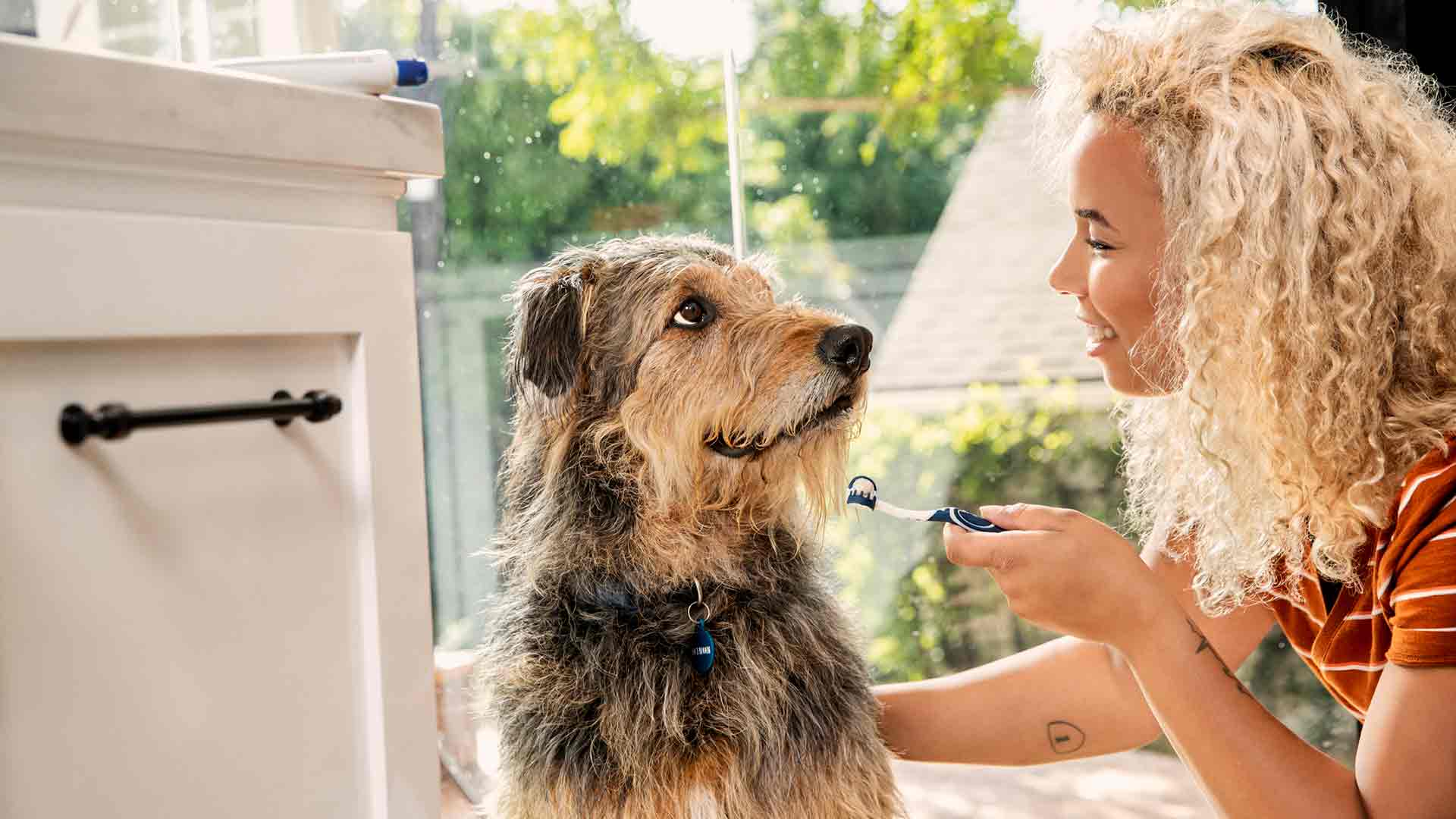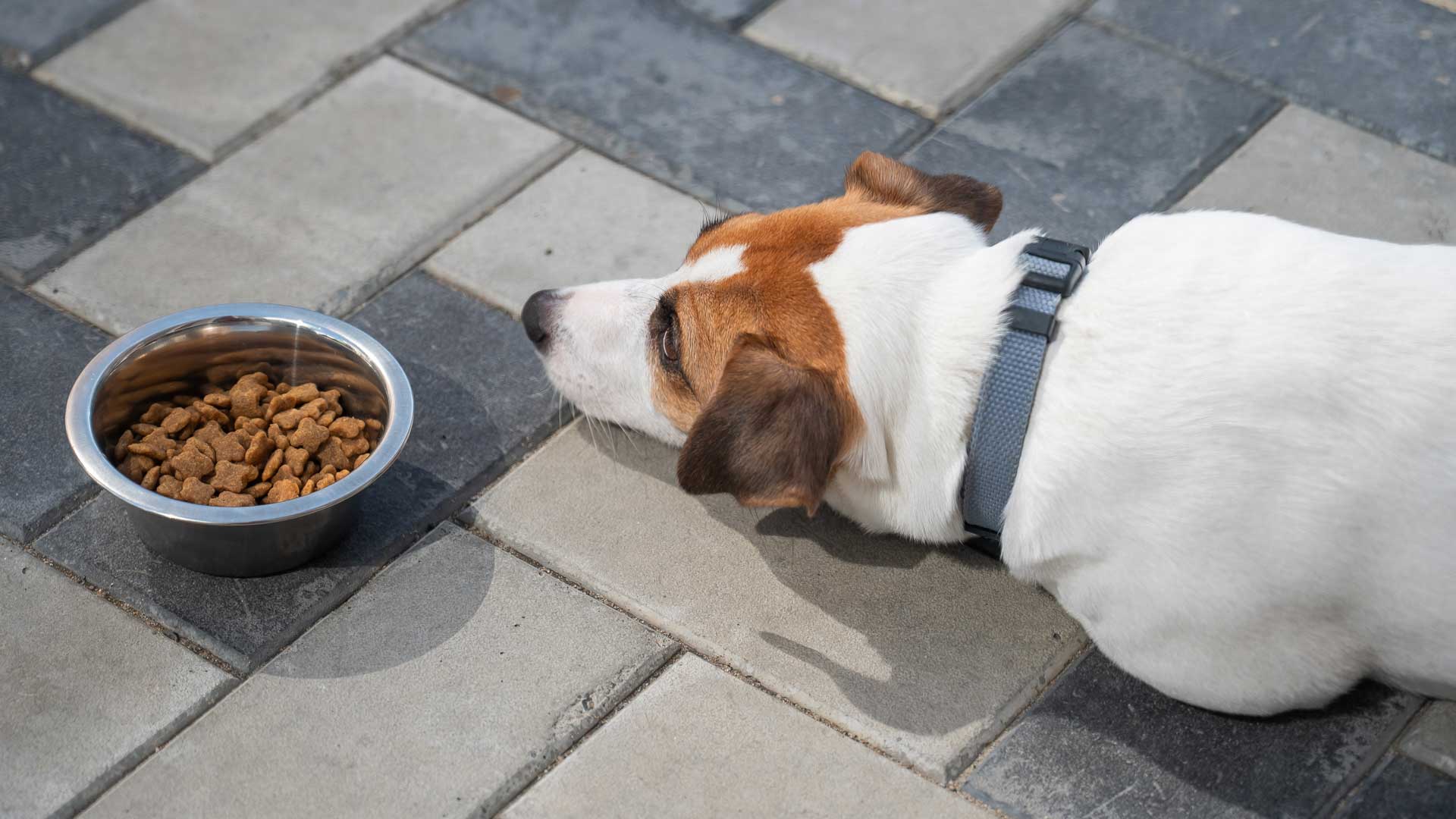pet dental care: what every pet owner should know
Your pet's mouth is a key part of their overall health. Just like people, pets can suffer from plaque buildup, gum disease, and tooth pain without proper oral care. The good news? With the right routine and regular checkups, pet dental care can be simple, safe, and stress-free. Our veterinarians can help you stay ahead of dental issues with personalized care and gentle cleanings that fit your pet’s needs.
Regular dental exams can help catch problems early before they become painful or costly. If it’s been a while since your pet’s last dental check, now is a great time to book an exam at your nearest Banfield and take the first step toward a healthier mouth. Banfield’s Active Care Plus and Senior Care Plus Optimum Wellness Plans® even include dental cleanings, making it easier to help keep your pet’s teeth and gums healthy.
In this article
Why dental health is important for pets?
What happens during a professional dental cleaning?
Is anesthesia necessary for pet dental cleanings?
How much do professional dental cleanings cost?
Signs of dental problems in pets
At-home dental care made simple
Dental care FAQs for pet owners
Are you ready to protect your pet's smile?
Why dental health is important for pets
Dental health plays a major role in your pet’s overall well-being. Over time, plaque, a sticky film of bacteria, builds up on teeth and hardens into tartar, which can irritate the gums and trigger an inflammatory immune response. If left untreated, this can lead to periodontal (dental) disease, causing pain, tooth loss, and infection.
But the impact doesn’t stop in their mouth. Dental disease has been associated with more serious health issues. Harmful bacteria from the mouth can enter the bloodstream and may affect vital organs. Routine dental cleanings help prevent these risks, which can help pets stay healthy and comfortable.
By practicing preventive dental care, you’re not only helping your pet avoid oral discomfort, you’re also helping to avoid more advanced procedures and unexpected veterinary costs down the road. Regular cleanings, exams, and at-home care go a long way in maintaining healthy teeth and gums.

What happens during a professional dental cleaning?
A professional dental cleaning at Banfield is a thorough, carefully monitored procedure designed to keep your pet safe and comfortable while giving their teeth the deep clean they need. Here’s what to expect, step by step:
- Pre-anesthesia evaluation – Before the procedure, your pet will receive a physical exam and pre-anesthetic bloodwork to check organ function and ensure they’re healthy enough for anesthesia.
- Anesthesia and monitoring – Once cleared, your pet is placed under general anesthesia, allowing the veterinary team to clean below the gumline where most problems start. Throughout the procedure, your pet’s vital signs are closely monitored by trained professionals to keep them safe and stable.
- Full mouth X-rays – Using dental radiographs, we take images of your pet’s teeth below the surface to detect issues like infections, tooth root abscesses, or bone loss that can’t be seen with the naked eye.
- Scaling and polishing – The veterinary team then performs a full cleaning, removing plaque and tartar from every tooth, both above and below the gumline. Teeth are then polished to smooth the enamel and reduce future buildup.
- Recovery and aftercare – Once the cleaning is complete, your pet is awakened from anesthesia and monitored during recovery. Your Banfield team will go over the results, share any findings, and recommend follow-up care or at-home tips to maintain your pet’s oral health.
These cleanings are performed by experienced veterinary teams using professional tools and protocols to help ensure your pet’s safety and comfort every step of the way.
Is anesthesia necessary for pet dental cleanings?
Yes, anesthesia is essential for a safe, thorough, and low stress dental cleaning. It allows veterinarians to carefully clean below the gumline, where plaque, tartar, and bacteria can cause painful infections and long-term damage. Anesthesia also ensures your pet stays still and comfortable throughout the procedure, enabling a complete oral exam, dental X-rays, and any necessary extractions or treatment with minimal pain or fear.
While non-anesthetic dental cleanings may remove some surface tartar, they can’t address problems beneath the gums, where most dental disease occurs. For this reason, we don’t offer these types of cosmetic cleanings. They may give the appearance of clean teeth but leave hidden issues untreated, potentially allowing pain and disease to continue unnoticed.
We understand that anesthesia can feel like a big step, especially for senior pets or those with health concerns. That’s why we follow strict pre-anesthetic screening and monitoring protocols to ensure your pet’s safety at every stage. From bloodwork to trained veterinary oversight, our goal is to provide gentle, effective dental care you can feel confident about.
How much do professional dental cleanings cost?
The cost of a professional dental cleaning for pets can vary widely depending on factors like your location, your pet’s size, and the condition of their teeth. On average, dental cleanings in the U.S. typically range from $300 to $700, though the price may increase if dental X-rays, extractions, or additional treatments are needed. These costs reflect the thorough care involved, including anesthesia, full-mouth evaluation, and skilled veterinary support.
While the upfront cost may seem significant, routine cleanings help prevent more serious (and expensive) issues like advanced periodontal disease, painful infections, and tooth loss. That can help you save money and help your pet stay comfortable as they age.
Our Optimum Wellness Plans® make dental cleanings more affordable. Active Care Plus and Senior Care Plus plans include a yearly dental cleaning, and all other plans offer a discount on dental cleaning. With convenient monthly payments, these plans help reduce unexpected costs and keep your pet’s teeth their healthiest year-round. Learn more about OWP
To get a better idea of what a dental cleaning may cost in your area, enter your zip code below.

Get price estimate
Signs of dental problems in pets
Pets can’t tell us when something’s wrong, so it’s important to watch for subtle signs of dental disease. Common symptoms include bad breath, excessive drooling, pawing at the mouth, difficulty eating, reduced appetite, or even avoiding chew toys. You might also notice red or swollen gums, loose or discolored teeth, or visible buildup of tartar.
These signs could point to conditions like gingivitis, infection, or painful tooth decay, which often worsen over time if left untreated. If you notice any of these symptoms, schedule a veterinary dental exam right away. Early evaluation and care can help relieve discomfort and prevent more serious health issues.

At-home dental care made simple
Taking care of your pet’s teeth at home doesn’t have to be complicated. It's recommended to brush your pet’s teeth daily or several times a week. Use a soft-bristled pet toothbrush or a finger brush, which are designed to comfortably reach along the gumline. Always use a pet-safe toothpaste — never human toothpaste. They often contain ingredients that are toxic to pets. Look for pet-safe toothpaste in flavors yours will enjoy, like poultry or peanut butter, to make brushing a more positive experience.
If brushing isn’t possible every day, there are other tools to help support oral health. VOHC-approved (Veterinary Oral Health Council) products include dental chews, specialized diets, and water additives. These can help reduce plaque and tartar buildup between cleanings and are especially helpful for pets who are still warming up to brushing.
Consistency is key, and even small steps go a long way. Your veterinary team can help you find the right mix of tools and routines to fit your pet’s needs and make at-home dental care simple and less stressful.
Dental care FAQs for pet owners
Why is dental care necessary for a pet’s overall health?
Dental care helps prevent pain, infection, and tooth loss, and it also plays an important role in protecting your pet’s heart, kidneys, and other organs. When dental disease is left untreated, harmful bacteria can enter the bloodstream and lead to serious health problems throughout the body.
What are the common signs of dental problems in pets?
Watch for bad breath, drooling, pawing at the mouth, reduced appetite, or discolored teeth. These signs can indicate pain, infection, or dental disease and should be evaluated by a veterinarian.
Can I use human toothpaste on my pet?
No, human toothpaste is not safe for pets. It often contains xylitol and other ingredients that can be toxic. Always use a pet-specific toothpaste designed for cats or dogs.
What happens during a professional veterinary dental cleaning?
Your pet is placed under anesthesia so the vet team can safely remove plaque and tartar from above and below the gumline. The procedure includes, scaling, polishing, and a full oral exam.
Is anesthesia necessary for a professional pet dental cleaning?
Yes. Anesthesia allows for a thorough cleaning and enables the vet to examine below the gumline where disease often hides. It also helps keep your pet calm and still during the procedure.
Are anesthesia-free cleanings recommended for pets?
No. Anesthesia-free cleanings only address surface plaque and can’t treat or detect disease under the gums. They may give a false sense of security while serious issues go unnoticed. Without anesthesia, pets may not feel safe or calm during the procedure.
What kinds of dental products or treats are safe and effective?
Look for VOHC-approved products, including dental chews, water additives, and special diets that help reduce plaque and tartar. Your vet can help recommend safe, effective options for your pet’s needs.
What is the VOHC seal?
The VOHC (Veterinary Oral Health Council) seal appears on dental products that meet scientific standards for plaque and tartar control. It’s a trusted way to know if a product is safe and effective.
Are hard chews like bones safe for a pet’s teeth?
No. Hard items like bones, antlers, or hooves can crack or break teeth, leading to pain and expensive dental procedures. Stick with vet-recommended dental chews that are safe to chew and digest.
How much does a dental cleaning cost for a dog vs. a cat?
Dental cleanings typically range from $300 to $700 for both dogs and cats, depending on factors like location, pet size, and the need for X-rays or extractions. An Optimum Wellness Plan can help reduce these costs.
How do I brush my pet’s teeth at home?
Use a soft pet toothbrush or finger brush and pet-safe toothpaste. Gently lift the lips and brush in small circles along the gumline. Start slowly, and reward your pet to build a positive routine.
Do senior pets need dental cleanings?
Yes, dental health is just as important for senior pets, and cleanings may even become more necessary as pets age. Your vet will tailor a plan based on your senior pet’s overall health and risk factors.
Can dental disease cause other health problems?
Absolutely. Untreated dental disease may lead to infections that spread through the bloodstream. Preventive care helps protect both oral and whole-body health.
Are you ready to protect your pet's teeth?
Book your pet’s dental exam and cleaning today. Find a Banfield vet near you
Published August 29, 2025
The information provided on this page is for informational purposes only and is not a substitute for professional veterinary advice. Always consult a veterinarian with any questions regarding your pet's health or medical condition. Never disregard or delay seeking professional veterinary advice based on information from this page.
 Mites and mange
Mites and mange Podcast - Not Just Fluff
Podcast - Not Just Fluff
